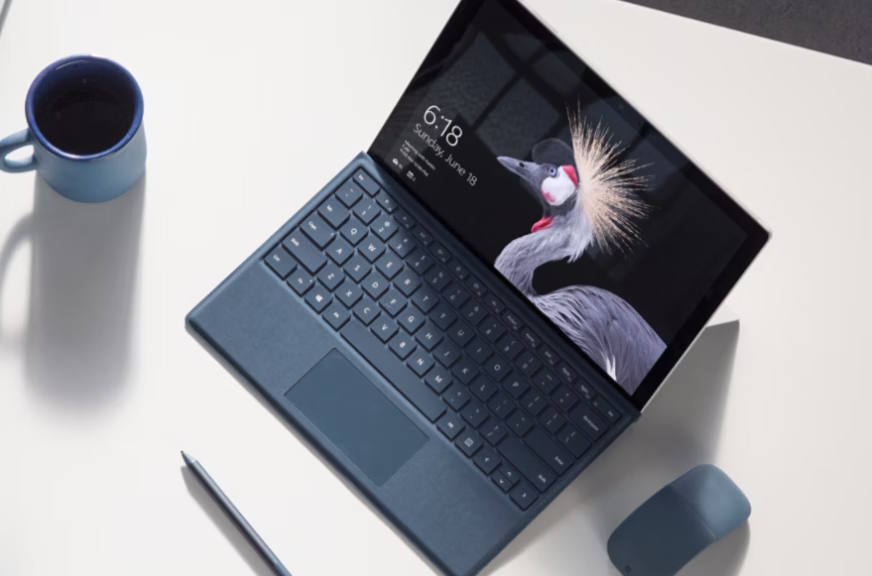In 2017, Microsoft released the Surface Pro 5, officially named just “Surface Pro.” It was the successor to the Surface Pro 4 (2015) and continued Microsoft’s vision of a premium 2-in-1 hybrid device, combining the portability of a tablet with the functionality of a laptop. The Surface Pro 5 retained many elements of its predecessor but introduced key refinements to improve performance, battery life, and user experience.
Evolution: How Surface Pro 5 Built Upon Its Predecessors
The Surface Pro 5 followed a line of evolving Surface devices:
- Surface Pro (2013) – The first real attempt at a Surface with a functional keyboard and stylus support.
- Surface Pro 2 (2013) – Improved battery life and introduced better hardware.
- Surface Pro 3 (2014) – Bigger display (12 inches) and a thinner, lighter design.
- Surface Pro 4 (2015) – Higher resolution, thinner bezels, and improved Surface Pen.
With the Surface Pro 5, Microsoft refined rather than revolutionized. It kept the same 12.3-inch PixelSense display (2736 x 1824 resolution) from the Pro 4 but focused on better efficiency and usability.
Key Features and Improvements

Upgraded Processors and Performance
The Surface Pro 5 featured Intel’s 7th-generation Kaby Lake processors (Core m3, Core i5, and Core i7), offering better performance and efficiency compared to the Skylake chips in the Surface Pro 4. This resulted in smoother multitasking and improved battery life.
Extended Battery Life
One of the major criticisms of the Surface Pro 4 was its battery life. Microsoft addressed this by optimizing power consumption, allowing the Surface Pro 5 to achieve up to 13.5 hours of video playback, a significant jump from the Pro 4’s 9-hour battery life.
Silent, Fanless Design (For Some Models)
The Core m3 and Core i5 models adopted a fanless design, making the device quieter and cooler under normal workloads. However, the Core i7 model still required a fan due to its higher power consumption.
Refined Surface Pen Experience
The new Surface Pen had 4,096 levels of pressure sensitivity, lower latency, and tilt support for better shading, making it an excellent tool for digital artists and note-takers. However, unlike previous models, the Surface Pen was no longer included and had to be purchased separately.
More Stable and Adjustable Kickstand
The 165-degree hinge allowed for a near-flat “Studio Mode” angle, making it more comfortable for drawing and note-taking compared to previous models.
Windows 10 Optimization
The Surface Pro 5 shipped with Windows 10 Pro and took full advantage of features like Windows Ink, Cortana, and improved touch and stylus input. It was also upgradeable to Windows 11, though with some limitations.
Better Thermals and Cooling
Thanks to more efficient processors and a redesigned thermal system, overheating issues seen in the Surface Pro 4 were significantly reduced.
What Microsoft Aimed to Achieve
Microsoft positioned the Surface Pro 5 as the ultimate laptop replacement. They wanted to target:
- Creative professionals (designers, artists, architects) with improved Surface Pen and Studio Mode.
- Business users looking for a lightweight and powerful device with Windows 10 Pro.
- Students and general consumers who needed a versatile device for work, entertainment, and portability.
Microsoft also intended to make the Surface Pro lineup more premium, reflected in their decision to remove the included Surface Pen, turning it into a separate purchase.
Issues and Drawbacks
While the Surface Pro 5 was well received, it wasn’t perfect. Here were some of its most common issues:
No USB-C Port
By 2017, USB-C was becoming a standard for premium devices, yet the Surface Pro 5 still relied on USB-A and the proprietary Surface Connect port. This was a major drawback for future-proofing.
Lack of Thunderbolt 3 Support
Since there was no USB-C or Thunderbolt 3, users couldn’t connect external GPUs or high-speed peripherals, limiting its expandability.
Keyboard and Surface Pen Sold Separately
Unlike the Surface Pro 4, the new Surface Pen was no longer included. The Type Cover keyboard also remained an optional purchase, increasing the overall cost.
Limited Performance for Heavy Tasks
While it performed well for general use, high-end video editing and gaming were not ideal on the Surface Pro 5, especially due to the lack of a dedicated GPU.
Windows 10 Updates Occasionally Caused Issues
Some users reported that Windows 10 updates caused battery drain issues, touchscreen glitches, and sleep-mode problems, though these were usually fixed in later patches.
How Good Was the Surface Pro 5 in Its Time?
Despite its drawbacks, the Surface Pro 5 was one of the best 2-in-1 devices of 2017. It was praised for:
- Excellent build quality and premium design
- Great display with accurate colors and sharp resolution
- Long battery life compared to its predecessor
- Highly responsive stylus support
- Fanless, silent operation on Core m3 and i5 models
However, it wasn’t a game-changer compared to the Surface Pro 4, as many improvements were iterative rather than revolutionary.
Conclusion
The Microsoft Surface Pro 5 (2017) was a strong refinement of an already successful product line. It delivered better battery life, improved performance, and a more comfortable form factor, making it an excellent choice for professionals and students alike. However, the lack of USB-C and expensive accessories made it less appealing for some buyers.
Overall, it was a solid 2-in-1 laptop replacement in 2017, though its incremental upgrades left some users waiting for a more significant leap in the Surface Pro 6 (2018). Nonetheless, it cemented Microsoft’s role as a leader in the hybrid laptop market.